
French postcard in the series 'Nos artistes dans leurs expressions' by Paris sur Scène, no. 1024.

Spanish collectors card in the Artistas de Cine Series by Chocolate Amattler, Barcelona, no. 34. Image: Martinez Surroca.
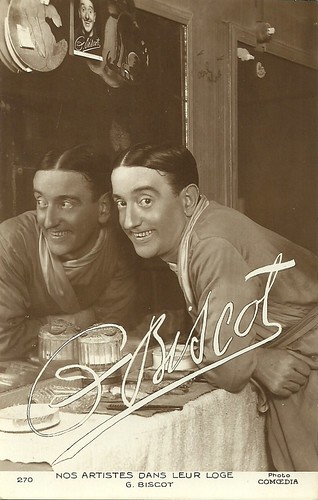
French postcard in the Nos Artistes dans leur loge series by Editions La Fayette, no. 270. Photo: Comoedia.
A star of the Folies-Bergères
Georges Biscot was born Gaston Georges Bouzac in Courbevoie, near Paris, in 1886 (some sources say 1889). He studied at the Lycée Jean-Baptiste-Say in Paris and l’Ecole Estienne. Destined to become a photogravure maker, he executed this profession for three years.
He then became a projectionist at Pathé in Joinville near Paris. In 1904 he was hired by the Concert Bobino de Montparnasse where he gathered the functions of film projectionist and comedian for the theatrical programme.
In 1906 he launched himself in an artistic career in the Parisian cafés-concerts, singing 'La valse brune' and 'Si mon cœur avait des roulettes' while moving on roller skates.
Georges Biscot debuted on the silver screen in 1913 in filmed songs, produced by Georges Lordier.
Soon he became a star of the music-hall of the Folies-Bergères, in particular when acting in 'La revue galante' (1914) next to Musidora, then in 'À la Parisienne (1916) where he did an imitation of Charles Chaplin.
In the same year, he returned to film in the crime serial parody Le pied qui étreint/The clutching foot (Jacques Feyder, 1916). Impressed by his comic talent, Feyder recommended Biscot to Louis Feuillade.
Feuillade used him in Vendémiaire (Louis Feuillade, 1918) with René Cresté, and in the 7-hour mystery serial Tih Minh (Louis Feuillade, 1918) with Mary Harald. He succeeded Marcel Lévesque in the parts of jocular characters in the Feuillade films.
Subsequently, Biscot had notable comic parts in the serials Barrabas (Louis Feuillade, 1919) with Blanche Montel, Les deux gamines/The Two Girls (Louis Feuillade, 1921) with Sandra Milovanoff. With Milovanoff, he acted again in L’orpheline/The orphan (Louis Feuillade, 1921), Parisette (Louis Feuillade, 1921) and Le fils du filibustier/The son of the pirate (Louis Feuillade, 1922).
His final collaboration with Feuillade was with Vindicta/Vengeance (Louis Feuillade, 1923), a classic melodrama in which he played a simple guy, Césarin de Rétameur, who knows all but doesn’t talk.

French postcard by Editions Filma in the Les Vedettes de l'Ecran series, no. 108.

Spanish collectors card in the Escenas selectas de cinematografía series. Photo: Gaumont. Georges Biscot and Fernand Herrmann in Les deux gamines (Louis Feuillade, 1921), presented in Spain as Las dos niñas de París.
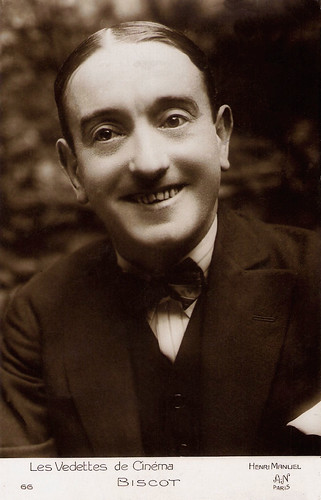
French postcard in the series Les Vedettes de Cinéma by A.N., Paris, no. 66. Photo: Henri Manuel.
A rugby man turned prankster
In the early 1920s at the Eldorado, Georges Biscot launched the revue 'Bibi-la-purée' by Alexandre Fontanes and André Mouésy-Éon. The play was such a giant hit that quickly a film version was staged, Bibi-la-Purée (1925), directed by Maurice Champreux.
In the same year Biscot peaked as the amateur cyclist in Le roi de la pédale/The Pedlar (Maurice Champreux, 1925). In 1926, he was a rugby man turned prankster in Le p’tit parigot/The Small Parisian One (René Le Somptier, 1926).
Biscot returned to Champreux for his last silent film Les cinq sous de Lavarède/The Five Cents of Lavarede (Maurice Champreux, 1927), but also for his first sound film Hardi les gars!/Hardi guys! (Maurice Champreux, 1930) with Mona Goya in the female lead.
In the 1920s Biscot also created other chansons, such as 'La Môme Biclo' (a song about the Tour de France with words by Cazalis and music by Dufas and Gardoni), 'Fernande' (1922, words by Nazelles, music by Mauprey), Elle sait conduire une automobile', and 'Cécile' (1926, words by Nazelles, music by Chantrier), created for the revue 'La foire aux fiancés' at the Théâtre du Châtelet.
He als made the songs 'Emilienne - c’est y toi?' and 'C’est pa.., pa…, c’est parisien' for the film La bande à Bouboule/Bouboule's gang (Léon Mathot, 1931).
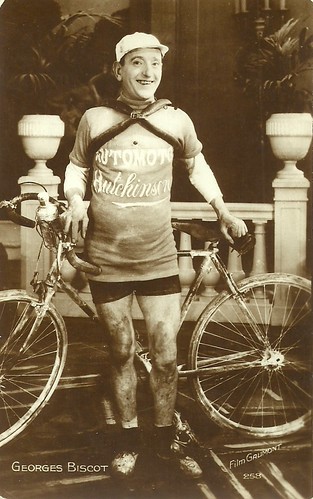
French postcard by Ed. Cinémagazine, no. 268. Photo: Film Gaumont. Publicity still for Le roi de la pédale (Maurice Champreux, 1925).

French postcard. Photo: Gaumont.

French postcard. Photo: Gaumont.
The most beautiful guy in France
During the 1930s, Georges Biscot remained a popular star of the Paris stage.
He played in only four films: Le clochard/Clochard (Robert Péguy, 1932), Six cent mille francs par mois/600,000 francs a month (Léo Joannon, 1933), a new adaptation of Bibi-la-purée (Léo Joannon 1934), and finally Le plus beau gosse de France/The most beautiful man in France (René Pujol, 1937) with Bernard Lancret in the title role, and also with Pauline Carton and Josseline Gaël.
During the Second World War, Biscot returned to the screen in major roles in three films: Un tel père et fils/The Heart of a Nation (Julien Duvivier, 1940) with Raimu, Michèle Morgan and Louis Jouvet, La cage aux rossignols/A Cage of Nightingales (Jean Dréville, 1943) with Noël-Noël, and La route du bagne/The road from prison (Léon Mathot, 1944) with Viviane Romance.
A few months after the release of these last two titles, Georges Biscot died in 1945 in Paris. He lies buried at the cemetery of Montrouge.
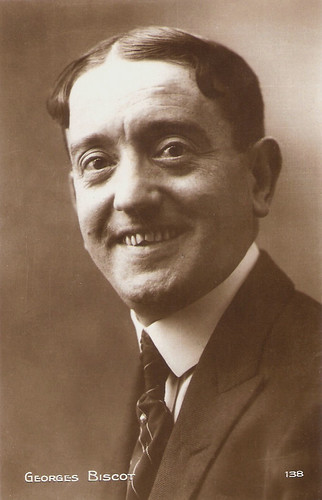
French postcard by Ed. Cinémagazine, no. 138.
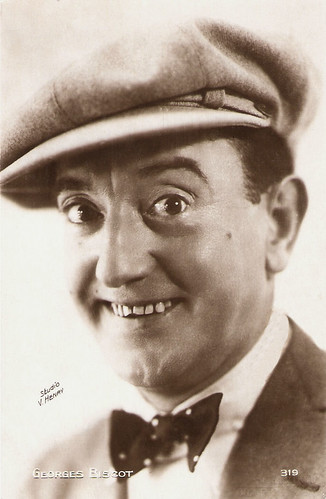
French postcard by Ed. Cinémagazine, no. 319. Photo Studio V. Henry.

German postcard by Ross Verlag, Berlin, no. 1174/1, 1927-1928. Georges Biscot aka Biscot Meyer.

German postcard by Ross Verlag, Berlin, no. 1174/3, 1927-1928. Georges Biscot, presented in Germany as 'Biscot Meyer', in L'orpheline/The orphan (Louis Feuillade, 1921).
Sources: Philippe Pelletier (CinéArtistes - French), Wikipedia (French and English), and IMDb.
This post was last updated on 12 April 2021.
No comments:
Post a Comment